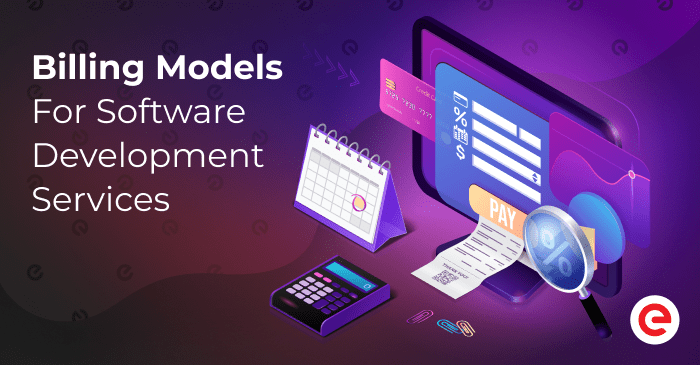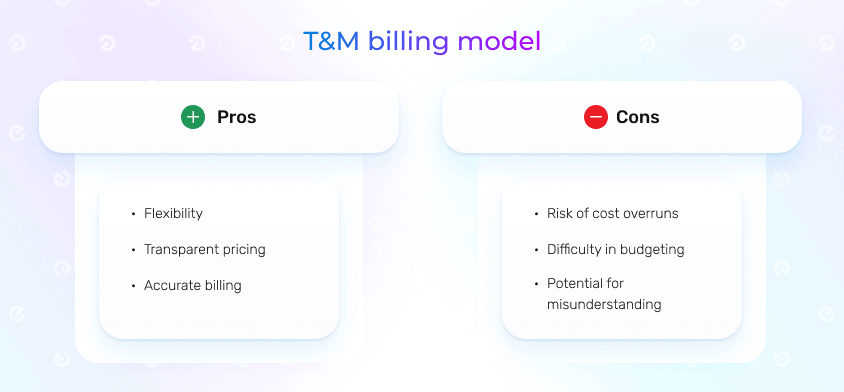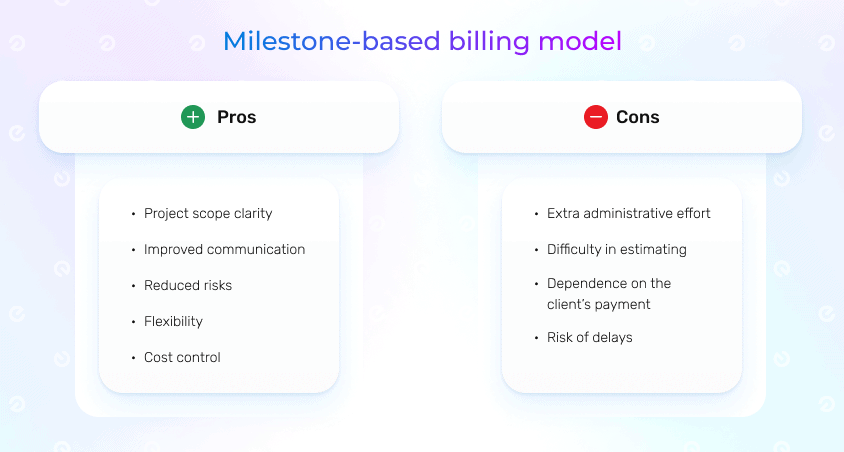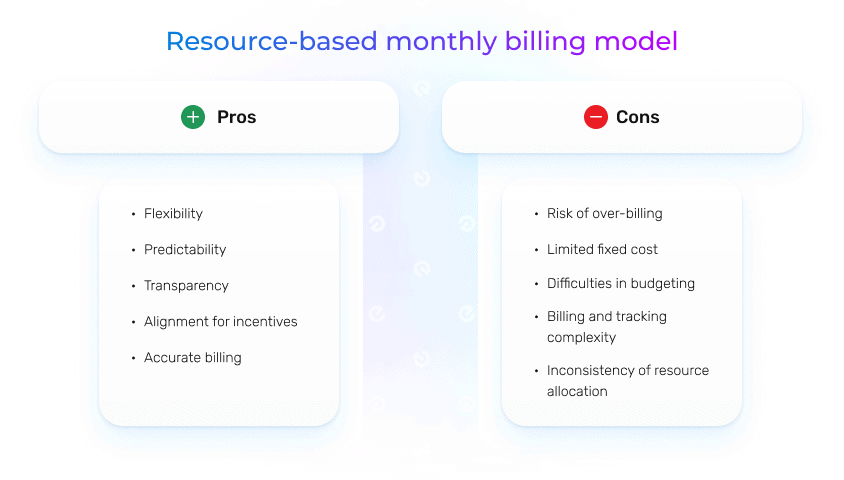
Updated: June 27, 2024
Published: June 20, 2017
Choosing a suitable billing model for software development services is crucial for the success of any project. Whether you’re a client or a development team, understanding the different options available and how to choose the right one is essential. In this article, we’ll take a closer look at the most commonly used billing models in software development, including time-and-materials, fixed-price, milestone-based, and resource-based models.
List of the Content
- T&M (Time and Materials) model
- Fixed-price billing
- Milestone-based billing model
- Resource-based monthly billing
- Conclusion
Software development billing models are the methods used to charge clients for the services provided by a software development team. Selecting the right billing model for software development services depends on the specific needs and goals of the project. It is important to have open and transparent communication between the client and development team to discuss each billing model’s pros and cons and choose the one that best aligns with the project requirements.
TIME AND MATERIALS (T&M) BILLING MODEL
Time and Materials (T&M) billing is a model used in a variety of industries, such as construction, engineering, and consulting, in which a client is charged for the actual time and materials used in a project. This model is often used when the project scope is not well defined or is subject to change.
The T&M billing model can be a beneficial option for both the client and the service provider. It offers flexibility and transparency for the client, allowing them to only pay for the exact services and materials they need. For the service provider, it allows them to bill for unique or one-off projects accurately and can also be a more secure and predictable source of income than other billing models.
How the T&M billing model works
T&M billing is relatively straightforward. The service provider tracks the time and materials used on a project and bills the client accordingly. The client is charged for the actual hours worked and any materials or expenses incurred during the project.
To calculate the cost of a T&M project, the service provider typically uses a standard hourly rate for labor and the actual cost of materials. Hourly rates can vary depending on the industry, the experience level of the workers, and other factors.
It’s important to note that the T&M billing model is a flexible way of billing that allows changes in scope, while other forms of billing are based on a set scope of work, and changes would require change orders.
Advantages of the T&M billing model
- Flexibility: It offers the client and service provider flexibility. If the scope of the project changes, the client only pays for the additional time and materials required rather than a whole new fixed-price contract. Service providers also benefit from the flexibility of T&M billing models as they can adjust their hours worked or materials used to match the client’s budget.
- Transparent pricing: With T&M billing, the client knows exactly what they are paying for and can see how the project cost is broken down by time and materials. It can benefit clients who want more control over their project costs.
- Accurate billing for unique or one-off projects: T&M billing allows service providers to bill for projects accurately since the cost is based on the actual time and materials used. That is particularly useful for specialized projects or projects with some unknown factors.
Disadvantages of T&M billing
- Risk of cost overruns: For clients, the risk of cost overruns is a potential downside to the T&M billing model. If the project takes longer than expected or requires more materials than anticipated, the final cost can be higher than originally budgeted.
- Difficulty in budgeting and forecasting: T&M billing can make it difficult for service providers to budget and forecast future income. It can be difficult to predict how many hours or how much in materials will be needed for a project, making it harder to plan for the future.
- Potential for misunderstandings or disputes: The model relies heavily on accurate tracking and clear communication between the client and service provider. Misunderstandings or disputes over the scope of work can lead to disagreements over the final cost.
T&M billing can benefit both the client and the service provider, offering flexibility and transparency. However, it also has its disadvantages, such as cost overruns, difficulty in budgeting and forecasting, and the potential for misunderstandings or disputes over the scope of work. The most important thing is to take the time to carefully consider which billing model is the best fit for your project, taking into account the unique needs and requirements of both parties involved.
FIXED-PRICE BILLING MODEL
A fixed-price billing model is a type of billing structure in which the client agrees to pay a fixed amount for the completion of a project, regardless of the amount of time or resources required to complete it. This type of billing model is commonly used in engineering, construction, and software development projects.
How fixed-price billing works
In this model, the client agrees to pay a fixed amount for the completion of a project, regardless of the number of resources or time required for it. This model contrasts with time-and-materials billing, in which the client is billed for the amount of time and materials used during the course of the project.
The contractor typically determines the fixed price by estimating the required time and resources. This estimate is often created using a detailed project plan that outlines the scope of the project, the deliverables, and the milestones. The client and contractor then negotiate the fixed price, taking into account any contingencies or unknown variables that may arise during the project.
The client is responsible for clearly defining the project scope, deliverables, and milestones. They should also ensure that the project plan is detailed and accurate. The client is also responsible for providing any necessary resources, such as materials or equipment, to the contractor.
The contractor is responsible for completing the project within the agreed-upon timeframe and budget. They should also be transparent about any contingencies or unknown variables arising during the project and work with the client to manage those risks.
Advantages of fixed-price billing
- Cost predictability for the client: One of the main benefits of fixed-price billing is that it allows the client to know upfront what the project will cost, making it easier to budget for and plan their finances.
- Reduced risk for the contractor: Fixed-price billing reduces the contractor’s risk by providing them with a guaranteed payment for the completion of the project, regardless of the amount of time or resources required.
- Clarity of project scope and deliverables: Fixed-price billing models require a clear definition of the project scope, deliverables, and milestones, which helps ensure that both the client and the contractor are on the same page regarding the project’s objectives.
- Potential for cost savings: Because fixed-price billing models require a detailed project plan, they can also help identify areas where costs can be reduced, resulting in potential savings for both the client and the contractor.
Disadvantages of the fixed-price billing model
- Limited flexibility: Once the fixed price is agreed upon, changes to the project scope or deliverables can be difficult to negotiate and may result in additional costs.
- Additional negotiation time: Negotiating the fixed price can be time-consuming and, if not done correctly, can lead to disagreements or misunderstandings later on.
- Potential for cost overruns: If the project plan needs to be more detailed and accurate, or if unforeseen challenges arise during the course of the project, the contractor may be forced to incur additional costs to complete the project. These additional costs may not be covered by the fixed price and can lead to cost overruns for the contractor.
- Limited ability to address unforeseen challenges: With a fixed-price billing model, the contractor may have limited ability to address unforeseen challenges in the project. That can put additional pressure on the contractor to complete the project within the agreed-upon timeframe and budget, leading to suboptimal solutions or lower-quality work.
Fixed-price billing can be valuable for clients and contractors, but it is important to approach it with care and attention to detail. By working together to develop a detailed project plan, clients and contractors can effectively negotiate a fixed price that benefits both parties.
Fixed-price billing suits projects with clearly defined scope, deliverables, and milestones. It is also well-suited for projects with low risk and well-defined challenges. Better options for projects with high uncertainty or rapidly changing requirements may exist.
MILESTONE-BASED BILLING MODEL
Milestone-based billing is a method of billing for services in which payments are tied to the completion of specific milestones rather than a traditional hourly or fixed-price model. This billing model is becoming increasingly popular as it provides greater clarity and transparency for the client and the service provider. Let’s explore the advantages of milestone-based billing, how it works, and how to implement it in your projects. We’ll also discuss why this model is becoming increasingly popular for projects of all sizes.
How the milestone-based billing model works
Milestone-based billing works by identifying and agreeing on a set of project milestones, with progress payments tied to the completion of each milestone. The milestones are typically defined as key deliverables or significant progress points in the project. For example, in software development, milestones could include the completion of the design phase, the completion of beta testing, the launch of the final product, etc.
Looking for more details on stages in the software development life cycle?
We suggest checking the article on the SDLC models, including popular methodologies, to handle the development process efficiently.
Once the milestones are established, a payment schedule is set up with the client, typically with a percentage of the total project cost due upon completion of each milestone. That helps ensure that both the client and service provider clearly understand what is expected at each project stage and when payments will be made. That also provides the flexibility to adapt the project if any major changes happen regarding the deliverables or the schedule.
Finally, the final payment is made upon completion of all milestones. It helps to reduce risk and improve communication throughout the project.
Advantages of using a milestone-based billing model
- Clarity of project scope and deliverables: With milestone-based billing, the project milestones are clearly defined and agreed upon upfront. This helps ensure that both the client and service provider understand clearly what is expected at each project stage. It can help prevent misunderstandings and scope creep later on.
- Improved communication and collaboration: Progress payments tied to milestone completion encourage regular communication and collaboration between the client and service provider. This helps ensure that both parties are on the same page and that any issues or concerns are addressed in a timely manner.
- Reduced risk for both client and service provider: By breaking a project down into smaller milestones, both the client and service provider are able to manage risk more effectively. The client can see progress and make payments as each milestone is completed rather than pay for the entire project upfront. Meanwhile, the service provider can mitigate the risk of not getting paid for work completed by receiving progress payments.
- Flexibility: Milestone-based billing allows the parties to adjust deliverables and schedules as needed. This is particularly useful in projects where requirements may change, or unforeseen issues arise. The milestone-based billing model provides the flexibility to make changes and still be able to stay on track.
- Cost control: With this billing model, the client only pays for completed work, which can provide cost certainty and better align the parties’ interests.
Disadvantages of milestone-based billing
- Extra administrative effort: Setting up and managing a milestone-based billing model can require more administrative effort than traditional billing models. Both the client and service provider will need to agree on the milestones and payment schedule, and progress will need to be tracked and reported on a regular basis.
- Difficulty in estimating time and costs: Accurately estimating time and costs for each milestone can be challenging, particularly for complex or highly technical projects. This can lead to delays and budget overruns if milestones are not completed as planned.
- Dependence on client’s payment: With milestone-based billing, the service provider’s payment depends on the client’s payments, which can cause a cash flow issue for the service provider, particularly for long-term projects.
- Dependence on the client’s reliability: The milestone-based billing model requires a high level of trust and reliability between the client and service provider, as the client has to make payments at specific points in the project. If the client does not pay as agreed, the service provider may be at risk of not getting paid for completed work.
- Risk of delays or change of scope: If milestones are not met on time, the project can suffer delays, and the final cost may increase; since this model is flexible to changes, it also can cause an increase in scope and the time required.
Despite these potential disadvantages, the milestone-based billing model can effectively manage projects and reduce the risk for both the client and service provider, as long as both parties are willing to invest the necessary time and effort to set it up and manage it properly. The key to success is to have clear communication, realistic planning, mutual understanding, and trust between the parties to achieve a successful outcome for the project.
Have additional questions on choosing the billing model for software development services?
Existek’s team is at your service. We’ll gladly share our extensive experience and help to choose the suitable engagement model according to your specific needs.
RESOURCE-BASED MONTHLY BILLING MODEL
A resource-based monthly billing model for software development services typically involves tracking the time and effort developers spend on a project and then bill the customer based on the total number of hours or resources consumed. That can be done by having developers track their time in a time-tracking tool and then using that information to generate invoices for the customer.
How resource-based monthly billing works
The resource-based monthly payment billing model is a recurring payment model that is often used for ongoing software development projects or long-term software development partnerships. Under this model, the client pays a monthly fee for a set of resources the software development team provides. These resources can include developers, project managers, or other team members.
The billing cycle could be monthly, quarterly, or annually. The agency would capture and track the hours consumed, and the client has the right to review and approve the same. This type of billing model aligns the incentives of the development team and the client, as both parties are interested in completing the project as efficiently as possible.
It is a popular billing method for software development agencies and consultancies, as it allows them to bill for the actual work performed rather than having to estimate the project’s cost upfront. It also allows for flexibility in case the scope of the project changes.
Advantages of a resource-based monthly billing model
- Flexibility: This model allows clients to scale up or down their usage of developer resources as needed, which can be useful for clients with fluctuating development needs.
- Predictability: Clients can predict their costs more accurately since they can control how many resources they use and how much they need to pay for the tasks or project completion.
- Transparency: Clients can easily see how much they are being charged for each resource and can make informed decisions about how to allocate their resources.
- Alignment of incentives: Both the client and dedicated development team have an interest in completing the project as efficiently as possible.
- Accurate billing: The client only pays for the actual work performed rather than an estimate of the cost upfront.
Disadvantages of a resource-based monthly billing
- Risk of over-billing: Clients may be overcharged if the development team is inefficient or if they are not aware of how many resources they are using.
- Limited fixed cost: Clients might not be able to do budgeting on this model as the cost is not fixed and could change as the resources are consumed.
- Difficulties in budgeting: Some clients may find it difficult to budget for development costs when they are billed based on the number of resources used, which can be difficult to predict in advance.
- Billing and tracking complexity: Racking resources and generating invoices can be time-consuming and requires proper management and tracking tools.
- Inconsistency of resource allocation: As developers and other resources may also work on multiple projects at the same time, it may become difficult to track resource allocation and identify what’s billable to the specific client.
It’s important to note that this billing model requires high trust and communication between the development team and the client. Both parties need to work together to clearly define the scope of the project, track progress, and manage any changes to avoid any confusion or unexpected costs.
CONCLUSION
When choosing the right billing model for software development services, it’s essential to consider the project scope and complexity, the development team’s size and experience, and the client’s preferences and needs. Some common billing models include fixed-price, time and materials, milestone-based and resource-based. Ultimately, it’s best to have a candid conversation with your clients to understand their preferences and goals before choosing a billing model.
Need assistance selecting models of engagement and billing suitable for your project?
Feel free to contact Existek. We are an offshore software development company that provides full-cycle services to deliver projects for various domains. Our team of experts is ready to answer your questions and address your specific requirements.
Frequently asked questions
What is the main benefit of the T&M billing model?
It brings flexibility to the project's scope and timeline. The client is only billed for the actual time and materials used, so the cost will be higher if the project takes longer or requires more resources than originally planned. However, the cost will be lower if the project is completed faster or with fewer resources than expected. It can be beneficial for projects that evolve as work progresses.
Why do teams choose the fixed-price billing model?
The fixed-price outsourcing project can provide a great deal of cost certainty for the client, as they know exactly what they will pay for the project upfront. However, it also puts a significant risk on the software development team, as they will be responsible for any cost overruns.
Why does the milestone-based billing model become popular?
This billing model is becoming increasingly popular for its transparency, flexibility, and improved communication and collaboration. It can help ensure the successful completion of projects and a positive working relationship between the client and service provider. Additionally, the client can see progress and get a working product at various project stages rather than waiting until the end.
What advantages does resource-based monthly billing have?
One advantage of the resource-based monthly payment model is that it allows for a more consistent cash flow for the software development team, as they receive a steady monthly income from the client. Additionally, this billing model can benefit clients who need ongoing development support or want to establish a long-term partnership with a software development team.




